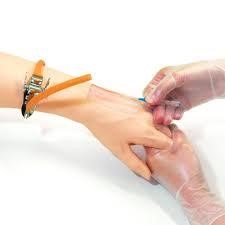A nurse is assessing the peripheral catheter insertion site of a client who is receiving an infusion. The nurse notices redness and warmth to the touch around the insertion site. The nurse should document the finding as which of the following complications?
Infiltration
Extravasation
Circulatory overload
Phlebitis
The Correct Answer is D
Choice A reason:
Infiltration is not correct: Infiltration occurs when the infused fluid or medication leaks into the surrounding tissue instead of flowing into the vein. This can lead to swelling, coolness, and pallor around the insertion site.
Choice B reason:
Extravasation is not correct: Extravasation is similar to infiltration but specifically refers to the infiltration of vesicant medications, which can cause tissue damage and necrosis.
Choice C reason:
Circulatory overload is not correct: Circulatory overload occurs when a large volume of fluid is infused too quickly, overloading the circulatory system and potentially leading to fluid overload, pulmonary edema, and other related symptoms.
Choice D reason:
Phlebitis is the appropriate fingings. The nurse should document the finding of redness and warmth around the peripheral catheter insertion site as phlebitis. Phlebitis is the inflammation of a vein, often caused by mechanical irritation, chemical irritation, or infection. In this case, the redness and warmth at the insertion site are indicative of inflammation, which is a common sign of phlebitis.

Nursing Test Bank
Naxlex Comprehensive Predictor Exams
Related Questions
Correct Answer is A
Explanation
The correct answer is A. Clean the wound from the center to the outer edges.
Rationale: The nurse should clean the wound from the center to the outer edges to prevent contamination of the wound bed by bacteria or debris from the surrounding skin. The nurse should wear clean gloves, not sterile gloves, to remove the dressing, as wet-to-dry dressings are not sterile and do not require a sterile technique.
The nurse should remove the tape by pulling parallel to and away from the skin, not from the center of the dressing, to minimize skin damage and pain. The nurse should not moisten the dressing before removal, as this would defeat the purpose of wet-to-dry dressings, which are intended to debride necrotic tissue by adhering to it and pulling it off when dry.
Correct Answer is D
Explanation
The client should check their oxygen equipment at least once daily to ensure proper functioning and safety. The other statements are incorrect and indicate a need for further teaching.
Whether you are a student looking to ace your exams or a practicing nurse seeking to enhance your expertise , our nursing education contents will empower you with the confidence and competence to make a difference in the lives of patients and become a respected leader in the healthcare field.
Visit Naxlex, invest in your future and unlock endless possibilities with our unparalleled nursing education contents today
Report Wrong Answer on the Current Question
Do you disagree with the answer? If yes, what is your expected answer? Explain.
Kindly be descriptive with the issue you are facing.
